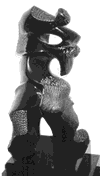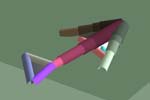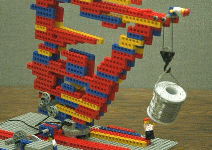


| In the Golem project (Genetically Organized Lifelike Electro Mechanics) we conducted a set of experiments in which simple electro-mechanical systems evolved from scratch to yield physical locomoting machines. Like biological lifeforms whose structure and function exploit the behaviors afforded by their own chemical and mechanical medium, our evolved creatures take advantage of the nature of their own medium - thermoplastic, motors, and artificial neurons. We thus achieve autonomy of design and construction using evolution in a limited universe physical simulation, coupled to off-the-shelf rapid manufacturing technology. This is the first time robots have been robotically designed and robotically fabricated. |
 |
 |
We are working on giving neural networks the ability to store and manipulate complex data structures of arbitrary size. Current research focuses on the possibility of representing large numbers of tree structures using the fractal attractors obtained by treating the network weights as an iterated function system (IFS).
One of the central difficulties of coevolutionary methods arises from "intransitive superiority" - in a two-player game, for example, the fact that A beats B, and B beats C, does not exclude the possibility that C beats A. Such cyclic superiority in a coevolutionary substrate is hypothesized to cause cycles in the dynamics of the population such that it "chases its own tail" - traveling through some part of strategy space more than once despite apparent improvement with each step. It is often difficult to know whether an application domain contains such difficulties and to verify this hypothesis in the failure of a given coevolutionary set-up. In this work we elucidate some of the issues and concepts in an abstract domain where the dynamics of coevolution can be studied simply and directly.
We define three simple "number games" that illustrate intransitive superiority and resultant oscillatory dynamics, as well as some other relevant concepts. These include the distinction between a player"s perceived performance and performance with respect to an external metric, and the significance of strategies with a multi-dimensional nature. These features alone can also cause oscillatory behavior and coevolutionary failure.
|
We believe that not just the software, but also the physical
body of a robot could be the result of an evolutionary
process.
A step in this direction is the evolution of buildable lego structures, designed by the computer through the combination of genetic algorithms and physical simulation. Examples of evolved structures are: the Lego Bridge that supports its weight on one side to reach the other; a crane and a table. EvoCAD is an interactive building tool where computer and human collaborate in creating a design. See also our project on the evolution of machines.
|

|



Our research explores the learning science at the juncture of evolution and game theory and the technology for on-line communities. We have developed and are currently testing a proof of concept of our research questions. Our focus is basic science, evaluating approaches for the automatic management of peer matching and motivation in learning communities. We will be implementing computational methods for matching learners together and perform experiments motivating peers to create appropriate challenges to each other. Our system is being implemented as a framework where central issues in educational multiplayer learning groups can be tested empirically. We will continue to develop our web delivery system. Usability and workflow will be addressed, from the varying perspectives of students, educators, and evaluators. We are currently actively testing this project, please visit us.